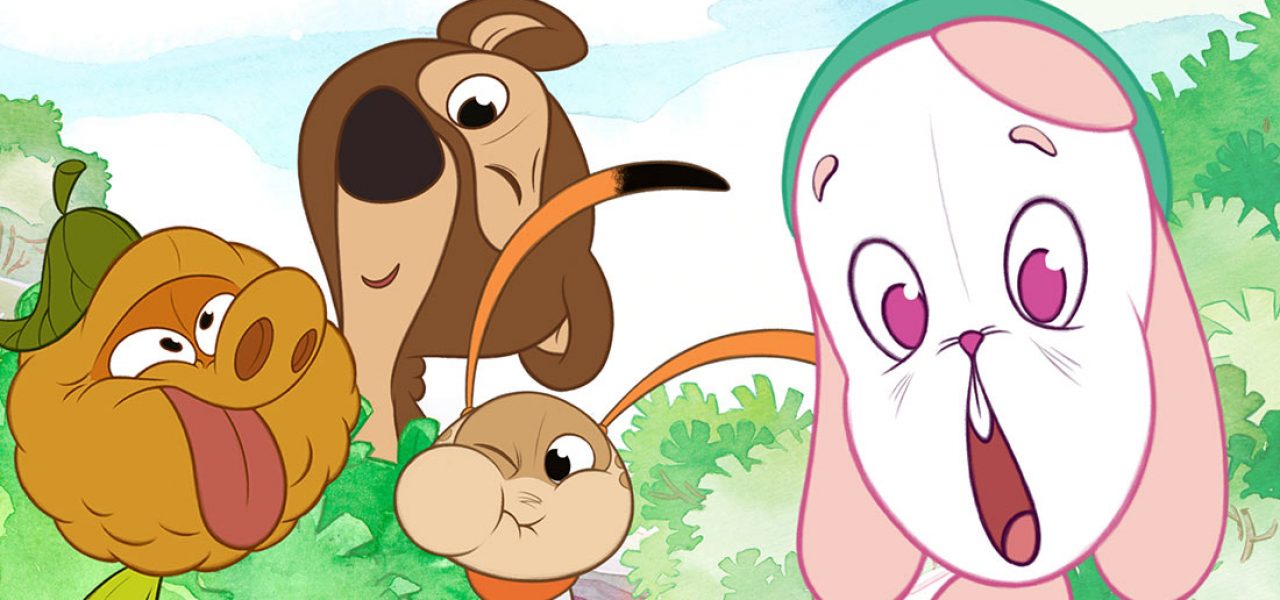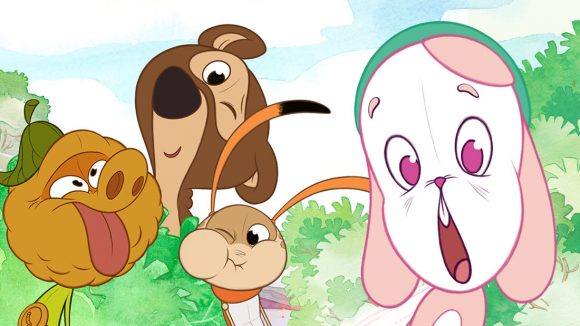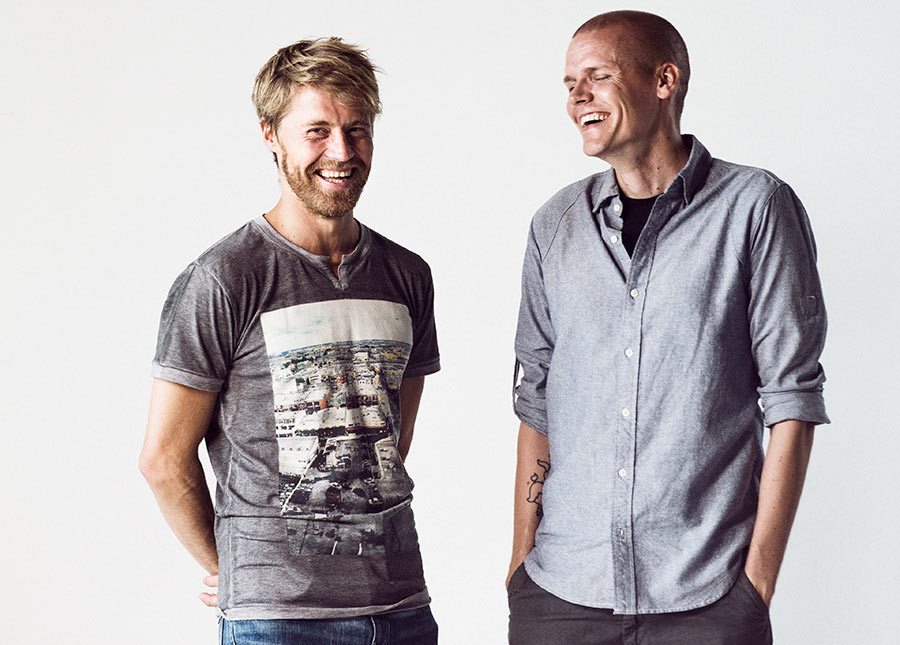

Finnish Studio Gigglebug Shares 7 Insights on Turning An App Into A TV Series
Last week in France, Cartoon Forum presented the animated shows of Europe’s future through 80 pitching sessions. Among the many Cartoon Forum success stories from years past is Gigglebug, a smile-inducing cross-media brand from Finland that was pitched at the event three years ago and has now culminated in a TV series.
When Gigglebug’s creators pitched at the forum, they found their co-producing broadcaster SRF and made two pre-sales. Like another famous Finnish property Angry Birds, Gigglebug took an unconventional app-to-broadcast journey. The first Gigglebug iPad game, released in 2013, has been downloaded over a million times, and has been followed up by several more apps inside Gigglebug’s universe.
Currently the studio is distributing its brand new Gigglebug series consisting of 52×5’; the first season has already launched in Finland to strong ratings. The Gigglebug series will premiere in Switzerland and Austria this month, followed by more countries in 2017, though the producers are still searching for an American broadcasting partner.
Cartoon Brew spoke recently to studio owners Joonas Utti (director) and Anttu Harlin (producer) via Skype, who shared their experiences and advice about succeeding in the intimidating world of TV markets, developing an authentic cross-media concept, and learning how to accept criticism.

1. On Cross-Media
The creators always approach Gigglebug and their upcoming projects in the same way: Identifying the core idea, an idea they can be passionate about for the next “like, forever,” Harlin said. “For Gigglebug, that core idea is sharing laughter. For one of our next projects it’s the idea of comparing; for another it’s opening packages. We build our whole world, all of our characters and stories on that core idea. Then we look at which old and new techniques are available and fit with our core idea. As long as we can go back to that core idea of sharing laughter, always, we have a successful base for a cross-media brand.”
“You should identify very early on in the process what your core idea is,” Utti stressed. “Otherwise you risk placing your brand and characters on existing models and that makes for old-fashioned or uninspired works.” As an example of how Gigglebug does this successfully, the creators point to their third app Face Race. With the iPhone’s front-facing camera, kids play a game of copying the silly faces of Gigglebug’s cast. It makes use of technological possibilities in a way that fits perfectly with the core idea of sharing laughter, making for a conceptually strong app.
2. On the Brand’s Popularity
The studio attribute Gigglebug’s success to its positivity and simplicity. “Happy entertainment—there’s a need for that,” said Harlin. “I’m sure many series have this same intention, but it can get lost through a certain edginess and coolness, with action scenes, witty dialogue and loud music. We’re approaching happiness more as the main intention behind our work. Parents often tell us Gigglebug is the happy show they had been missing. Its simple honesty and sweetness is what makes Gigglebug stand out.”
“On top of that Gigglebug is not just entertainment; there’s also an educational value,” Utti said. Not being discouraged by failure, thinking positive and getting up again—these are all curricular themes in Finland, a curriculum that has recently drawn interest from all over the world. It certainly helped establish the brand that Finland was the number one country in education at the time of Gigglebug’s launch.
3. On Attending Markets
In order to sell the series, Harlin traveled to markets everywhere. With a background in theater instead of business, he remembers being very insecure in the beginning. “But after a while you realize all these business people are just that—people, with different needs. When talking to someone, somehow you have to get your confident and happy attitude on, and hopefully not feel the pressure to sell to him or her. The best thing you can do in a business meeting is bring your passion to the table, so it doesn’t feel like pure business as usual.”
Despite his primarily creative role, Utti finds it important to understand what it means to sell the brand. “As a director I have to understand my audience, and Gigglebug’s first audience isn’t three-to-five-year-old kids—it’s the business people. Before we reach our core audience—the children—I have to reach and thus understand the broadcasters and distributors.”
4. On Receiving Feedback
No brand is born perfect, neither was Gigglebug. On markets and during workshops the creators received lots of feedback—difficult at first but so obvious in retrospect, they recalled. “Once a workshop mentor told us to make the colors brighter,” Utti said. “That was a pretty difficult moment for me as a director. But Anttu [Harlin] has told me a hundred times—it’s always worth it to listen to comments, because it might just be about something important that we ourselves missed. Even if the comment itself has got it wrong, the reason the comment was made in the first place shows that something can be improved.” Harlin added, “The best comment someone can give is actually a question, not a solution.”
5. On Having (or Building) Confidence
While receiving feedback is very valuable, in the end you should always ask internally, “Does this feel good to me?” Harlin said. “You have to keep believing in your own judgement and in that core idea that you developed.”
If you lose your confidence in a certain area, the creators advise to make sure to regain it. “Sales meetings are intimidating as-is already,” Harlin said. While selling the series a buyer once said the Gigglebug show was for younger kids than the stated three-to-six-year-old target group. The studio then hired a research company to gather data on kids’ responses to the series, which proved it to be perfect for the target group, just so they wouldn’t have to deal with the fear of not getting it right.
Another thing the creators realized along the way is that when buyers don’t acquire the show it doesn’t mean the show is bad. “Usually, it means the buyer didn’t have the right slot available,” Harlin said. “Or it means they already have an animal show and are now looking for a vehicle show. You shouldn’t take No’s too personally.”
6. On the Power of Traditional Animation
The brand’s hand-drawn frame-by-frame animation will immediately strike animation fans. The creators have found parents actually say it looks different than what they’re used to—a funny paradox considering Gigglebug’s nostalgic design, but logical if you look at the cut-out, tweened and 3D animation currently available in the app and television markets. “Parents enjoy it because there’s something recognizable in it for them,” Utti said. “Kids enjoy it because they understand how it’s made—they see that these are drawn, so it’s more approachable. This is especially important because the iPad is so shiny. If we have something that reminds users of picture books it makes them more comfortable.” Harlin added that their pipeline is still competitive, thanks to the possibilities that TVPaint offers.
7. On Partnerships
One guiding principle that the creators took on from the beginning is: Let’s say ‘yes’ to new partnerships. “We look at new partnerships as an adventure,” Utti said. “If it looks interesting, let’s go for it, let’s work with these guys and take the project forward. All too often you stop and start second guessing things, becoming really protective of your project, and then momentum passes and you end up with nothing. We didn’t want that to happen to Gigglebug.”
The process of letting go is key to the studio’s growth, Harlin said. Following the first thirteen self-made presales, now they have a distributor so Harlin and Utti can concentrate on new parts of the brand, like licensing, toys, music, and books. “We just know the brand so well. So with every part of the Gigglebug brand we take it to a certain level first, hands-on to ensure the right tone of voice and quality. Then we hand it off and trust our partners.”

